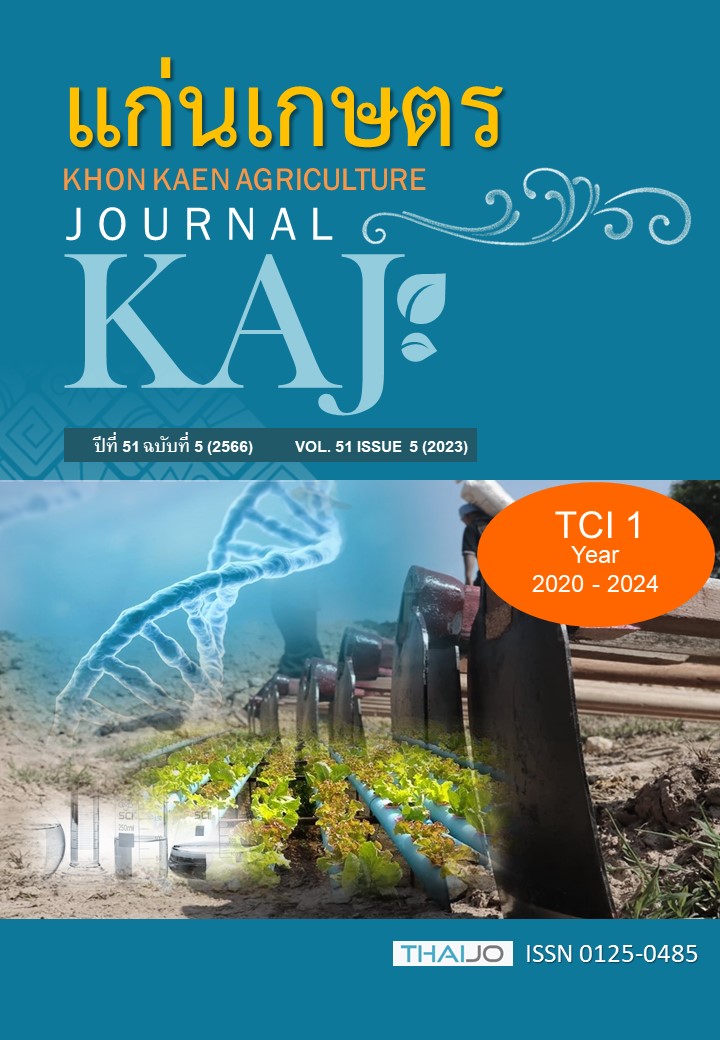การศึกษาความสามารถในการอุ้มน้ำของวัสดุปลูกที่แตกต่างกันที่มีขุยมะพร้าวเป็นส่วนผสมหลัก
Main Article Content
บทคัดย่อ
การศึกษาความสามารถในการอุ้มน้ำของวัสดุปลูกมีบทบาทสำคัญในการกักเก็บน้ำ และรักษาสมดุลของความชื้นในวัสดุปลูก การทดลองนี้มีวัตถุประสงค์เพื่อศึกษาความสามารถในการอุ้มน้ำของวัสดุปลูกที่แตกต่างกันที่มีขุยมะพร้าวเป็นส่วนผสมหลักด้วยวิธีการใช้เครื่องวัดแรงดึงของน้ำในดินกับวิธีการวางวัสดุปลูกบนทราย โดยทำการศึกษาวัสดุปลูก 6 สูตร คือ 1) ขุยมะพร้าว 2) ขุยมะพร้าว:ทราย อัตราส่วน 2:1 3) ปุ๋ยหมักขุยมะพร้าว 4) ปุ๋ยหมักขุยมะพร้าว:ทราย อัตราส่วน 2:1 5) ปุ๋ยหมักขุยมะพร้าว: ขุยมะพร้าว อัตราส่วน 2:1 และ 6) ปุ๋ยหมักขุยมะพร้าว:ขุยมะพร้าว:ทราย อัตราส่วน 2:1:1 โดยแบ่งออกเป็น 2 การทดลอง คือ
การทดลองที่ 1 ศึกษาความสามารถในการอุ้มน้ำของวัสดุปลูกด้วยเครื่องวัดแรงดึงของน้ำในดินที่ระดับ 1 kPa พบว่า วัสดุปลูกสูตรที่
1-6 มีความสามารถในการอุ้มน้ำ เท่ากับ 36.54, 18.43, 28.59, 23.05, 30.21 และ 28.74 % (v/v) ตามลำดับ การทดลองที่ 2 ศึกษาความสามารถในการอุ้มน้ำของวัสดุปลูกโดยวิธีวางวัสดุปลูกบนทราย ผลการทดลอง พบว่า วัสดุปลูกปุ๋ยหมักขุยมะพร้าว มีความสามารถในการอุ้มน้ำสูงที่สุดที่ 48 ชั่วโมง รองลงมาได้แก่ วัสดุปลูกปุ๋ยหมักขุยมะพร้าว:ทราย ปุ๋ยหมักขุยมะพร้าว:ขุยมะพร้าว และปุ๋ยหมักขุยมะพร้าว:ขุยมะพร้าว:ทราย มีความสามารถในการอุ้มน้ำที่ 24 ชั่วโมง และ ขุยมะพร้าว:ทรายมีความสามารถในการอุ้มน้ำต่ำที่สุดที่ 12 ชั่วโมง ทั้งนี้ วัสดุปลูกที่มีส่วนผสมที่แตกต่างกันส่งผลต่อความสามารถในการอุ้มน้ำที่แตกต่างกัน
Article Details

อนุญาตภายใต้เงื่อนไข Creative Commons Attribution-NonCommercial-NoDerivatives 4.0 International License.
เอกสารอ้างอิง
กรมพัฒนาที่ดิน. 2553. คู่มือการปฏิบัติงาน กระบวนการวิเคราะห์พืช ปุ๋ย และสิ่งปรับปรุงดิน. กระทรวงเกษตรและสหกรณ์, กรุงเทพฯ.
นพดล ชุ่มอินทร์ และทัศนุพันธุ์ กุศลสถิตย์. 2563. ผลของวัสดุปลูกต่อการเจริญเติบโตของเมล่อนโดยระบบปลูกพืชไม่ใช้ดิน. วารสารเกษตรพระวรุณ. 17: 33-40.
มัตติกา พนมธรนิจกุจ. 2549. การจัดการดินและน้ำเพื่อระบบการเกษตรอย่างยั่งยืน. ภาควิชาปฐพีศาสตร์และอนุรักษ์ศาสตร์ คณะเกษตรศาสตร์ มหาวิทยาลัยเชียงใหม่, เชียงใหม่.
สุนทรี ยิ่งชัชวาลย์ และกุมุท สังขศิลา. 2534. ค่าพิกัดบนของความเป็นประโยชน์ต่อพืชของน้ำในชุดดินกำแพงแสน. วารสารวิทยาสารเกษตรศาสตร์ สาขาวิทยาศาสตร์. 25(2): 177-190.
Ahmad, I., T. Ahmad, A. Gulfam, and M. Saleem. 2012. Growth and flowering of gerbera as influenced by various horticultural substrates. Pakistan Journal of Botany. 44: 291-299.
Annika, N., K. Stefan, S. Dietmar, F. Nadja, and D. Dennis. 2022. Soilless tomato production: effects of hemp fiber and rock wool growing media on yield, secondary metabolites, substrate characteristics and greenhouse gas emissions. Horticulturae. 272: 1-17.
Arenas, M., C. S. Vavrina, and J. A. Cornell. 2002. Coir as an alternative to peat in media for tomato transplant production. Hortscience. 37: 309-312.
Asiah, A., R. I. Mohd, K. Y. Mohd, M. Marziah, and M. Shaharuddin. 2004. Physical and chemical properties of coconut coir dust and oil palm empty fruit bunch and the growth of hybrid heat tolerant cauliflower plant. Pertanika Journal of Tropical Agricultural Science. 27: 121-133.
Awang, Y., A. Shazmi, R. B. Mohamal, and A. Selamat. 2009. Chemical and physical characteristics of cocopeat-based media mixtures and their effects on the growth and development of Celosia cristata. American Journal of Agricultural and Biological Sciences. 4: 63-71.
Benjamin, N. M., and O. N. Pricilla. 2013. Changes in moisture retention properties of five waste materials during short-term mesophilic composting. Compost Science and Utilization. 6: 67-73.
Brian, E. J., R. D. Wright, and M. C. Barnes. 2010. Methods of constructing a pine tree substrate from various wood particle sizes, organic amendments, and sand for desired physical properties and plant growth. Hortscience. 45: 103-112.
De Boodt, M., and O. Verdonck. 1972. The physical properties of the substrates in horticulture. Acta Horticulturae. 26: 37-44.
Dede, O. H., G. Dede, S. Ozdemir, and M. Abad. 2011. Physicochemical characterization of hazelnut husk residues with different decomposition degrees for soilless growing media preparation. Journal of Plant Nutrition. 34: 1973-1984.
Doorenbos, J., and A. H. Kassam. 1979. Yield response to water. FAO Irrigation and DrainCce, Paper 33, Rome.
Eleonora, F. R., A. Stefan, and N. Thomas. 2018. Water retention characteristics of coarse porous materials to construct purpose-designed plant growing media. Soil Science and Plant Nutrition. 64: 181-189.
Hady, A. M., and E. I. Dardiry. 2006. Improving hydrophysical properties ouality of compost. Journal of Applied Sciences Research. 2: 137-1141.
Handreck, K. A. 1983. Particle size and the physical properties of growing media for containers. Communications in Soil Science and Plant Analysis. 14: 209-222.
Jana, P., and S. S. Boxi. 2020. Studies on pH, conductivity, and moisture retention capacity of coir pith for its application as the plant growing medium. Journal of Natural Fibers. 1: 1-7.
Khalaj, M., M. Amiri, and S. S. Sindhu. 2011. Response of different growing media on the growth and yield of gerbera in hydroponic open system. Indian Journal of Horticulture. 68: 583-586.
Kukal, S. S., D. Saha, A. Bhowmik, and R. K. Dubey. 2012. Water retention characteristics of soil bio-amendments used as growing media in pot culture. Journal of Applied Horticulture. 14: 92-97.
Maite, A. R., I. V. Marta, F. L. Miguel, L. S. Socorro, and E. L. María. 2022. Improving growing substrates by adding the seaweed Cystoseira baccata. Journal of Applied Phycology. 34: 3177-3188.
Meerow, A. W. 1994. Growth of two subtropical ornamentals using coir (coconut mesocarp pith) as a peat substitute. Hortscience. 29: 1484-1486.
Michael, R. E., and M. G. Mary. 2007. Physical properties of sphagnum peat-basedroot substrates amended with perlite or parboiled fresh rice hulls. Horttechnology. 17: 312-315.
Michel, J. C. 2009. Influence of clay addition on physical properties and wettability of peat-growing media. Hortscience. 44: 1694-1697.
Michel, J. C. 2010. The physical properties of peat: a key factor for modern growing media. Mires and Peat Journal. 6: 1-6.
Nieto, A., G. Gascó, J. Paz-Ferreiro, J. M. Fernández, C. Plaza, and A. Méndez. 2016. The effect of pruning waste and biochar addition on brown peat based growing media properties. Scientia Horticulturae. 199: 142-148.
Paradelo, R., R. Basanta, and M. T. Arral. 2019. Water-holding capacity and plant growth in compost-based substrates modified with polyacrylamide. Scientia Horticulturae. 243: 344-349.
Patricia, N., A. Manual, P. Rosa, M. Angel, and N. Vicente. 2003. Influence of particle size on physical and chemical properties of coconut coir dust as container medium. Communications in Soil Science and Plant Analysis. 34: 593-603.
Raviv, M., and J. H. Lieth. 2008. Soilless culture theory and practice. Elsevier, London.
Raviv, M., J. H. Lieth, D. W. Burger, and R. Wallach. 2001. Optimization of transpiration and potential growth rates of ‘Kardinal’ rose with respect to root-zone physical properties. Journal of the American Society for Horticultural Science. 126: 638-643.
Sánchez, R. A., M. C. Castorena, and P. S. García. 2008. Physical and micromorphological properties of organic and inorganic materials for preparing growing media. Acta Horticulturae. 779: 577-582.
Schmilewski, G. 2008. The role of peat in assuring the quality of growing media. Mires and Peat Journal. 3: 1-8.
Sujitha, E., and K. Shanmugasundaram. 2017. Assessment of soil moisture characteristics curve for greenhouse growing media. International Journal of Current Microbiology and Applied Sciences. 6: 3515-3520.
Veihmeyer, F. J., and A. H. Hendrickson. 1931. The moisture equivalent as a measure of the field capacity of soils. Soil Science. 32: 181-194.
Wang, D., M. Z. Gabriel, D. Legarg, and T. Sjulin. 2016. Characteristic of growing media mixes and application for open-field production of strawberry (Fragaria ananassa). Scientia Horticulturae. 198: 294-301.


